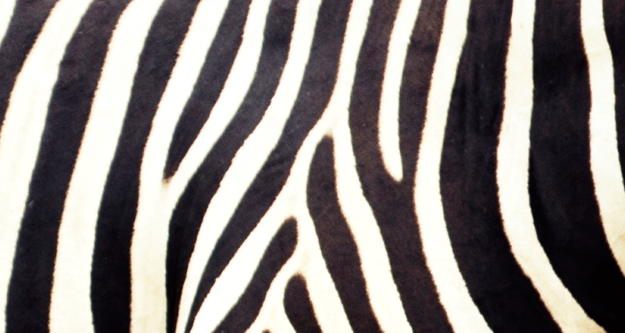
This is consistent with the flies' well-documented attraction to warmer temperatures and provides indirect support for the proposed hypothesis. This is because the black stripes are warmer than the surrounding grey areas in the sun, but not in the shade. We found that horseflies spend more time walking on thin black stripes than surrounding grey areas as expected by chance, but only when the substrate is sunlit. To test this hypothesis, we performed a field experiment with tabanids walking on a host-imitating grey test target with vessel-mimicking thin black stripes which were slightly warmer than their grey surroundings in sunshine, while under shady conditions both areas had practically the same temperature as demonstrated by thermography.
#Animals with stripes skin
We propose here a plausible hypothesis why biting horseflies avoid host animals with striped pelages: in sunshine the temperature gradients of the skin above the slightly warmer blood vessels are difficult to distinguish from the temperature gradients induced by the hairs at the borderlines of warmer black and cooler white stripes. The most thoroughly experimentally supported advantage of zebra stripes is their visual unattractiveness to horseflies (tabanids) and tsetse flies. No less a source than Darwin doubted this explanation, and theories such as bug repellants and temperature control have some support today. "I think it's probably still too early to say with any certainty which of the many competing hypotheses about the zebra stripes is correct! It's also quite possible the stripes evolved for multiple functions," Hughes told IFLScience.Multiple hypotheses have been proposed for possible functions of zebra stripes.

So it could be that it's only a very 'split second' effect.”Īlternatively, Hughes says, stripes may not be about camouflage at all. “The single target game was time-limited, whereas the subjects had as much time as they liked to catch all the targets in the multiple target game. Hughes told IFLScience that her findings so far are “counter-intuitive”, indicating that stripes may actually be more useful in isolation than in groups, but this may reflect the preliminary nature of the work. “Motion may just be one aspect in a larger picture,” she said. “Now we need to consider whether color, stripe width and spatial patterning, and a predator's visual system could be important factors for animals to avoid capture.” Moreover, in an earlier version of her research published last year, Hughes found that stripes are at least better protection than spots or other patterns. Given how successful zebras have been, Hughes is not ready to give up the motion dazzle theory entirely. With multiple targets any form of stripes made the prey more vulnerable, although at least the horizontal pattern on a zebra's hindquarters no longer made them more of a target than stripes running in other directions would." “For an isolated target, plain gray carried a similar risk to lines perpendicular or diagonal to the direction of motion (vertical on a zebra), while parallel lines assisted the predator. This could be due to how different stripe orientations interact with motion perception, where an incorrect reading of a target's speed helps the predator to catch its prey.” “Surprisingly, we also found no benefit of stripes when multiple targets were presented at once, despite the prediction that stripes should be particularly effective in a group scenario. “We found that when targets are presented individually, horizontally striped targets are more easily captured than targets with vertical or diagonal stripes,” said Hughes. Her findings are reported in Frontiers of Zoology.

Seventy years later Hughes tested the idea by having 60 participants chase moving objects with differing patterns around a screen, either singly or in groups. However, the idea was based more on theory than experimental research. Hughes says that the idea of “ motion dazzle” as a form of camouflage was so popular that ships in World War I and II were painted with geometric shapes in the hope that they would confuse enemies. When Goffin’s Cockatoos Go Cashew-Hunting They Bring A Whole Toolkit


 0 kommentar(er)
0 kommentar(er)
